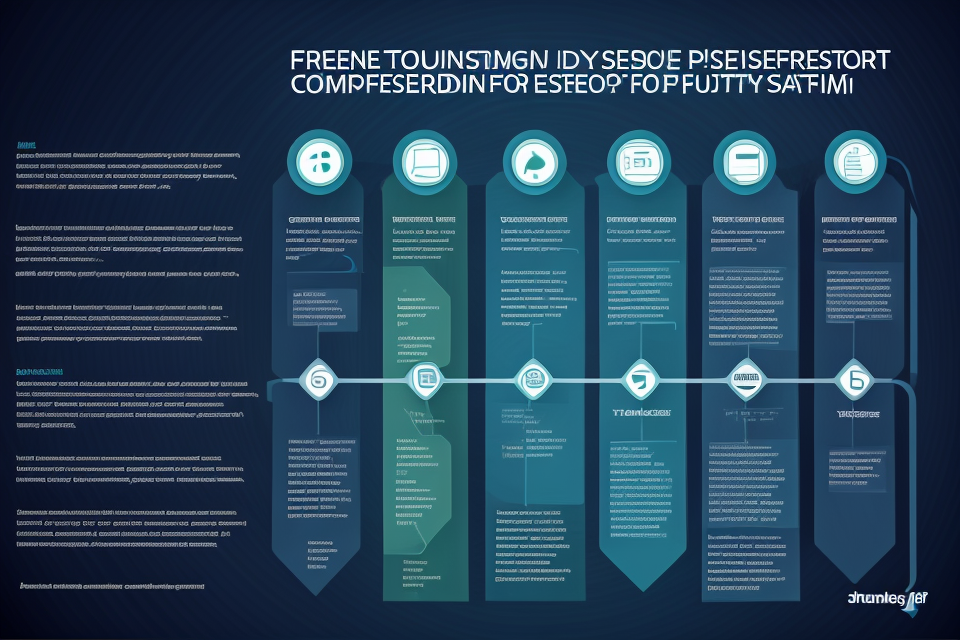In today’s dynamic business world, it is essential to understand the market trends and competition to stay ahead of the game. Industry analysis is a tool that provides valuable insights into the functioning of a particular industry. It involves examining the market structure, competition, consumer behavior, and other critical factors that affect the industry’s performance. This comprehensive guide will delve into the basics of industry analysis, providing you with a solid understanding of the topic. So, buckle up and get ready to explore the world of industry analysis!
What is Industry Analysis?
Definition and Importance
Industry analysis is the process of examining and understanding the various factors that influence the operation and performance of a particular industry. It involves the assessment of the industry’s current and potential market size, market share, competition, growth prospects, trends, and regulatory environment. The goal of industry analysis is to provide businesses with valuable insights that can help them make informed decisions about their products, services, pricing, marketing strategies, and overall business strategies.
Industry analysis is crucial for businesses because it helps them understand the competitive landscape of their industry, identify opportunities for growth and expansion, and develop effective strategies to achieve their goals. By analyzing industry trends and patterns, businesses can identify emerging technologies, consumer preferences, and market shifts that can impact their bottom line. Additionally, industry analysis can help businesses stay ahead of the competition by identifying potential threats and opportunities and developing contingency plans to address them.
The role of industry analysis in decision-making cannot be overstated. It provides businesses with a comprehensive understanding of the industry‘s strengths, weaknesses, opportunities, and threats (SWOT analysis), which can inform decision-making at every level of the organization. Whether it’s developing a new product, expanding into new markets, or adjusting pricing strategies, industry analysis can provide valuable insights that can help businesses make informed decisions that drive growth and profitability.
Types of Industry Analysis
When it comes to industry analysis, there are several different types of analyses that can be conducted to gain a deeper understanding of the industry and its dynamics. Some of the most common types of industry analysis include:
PESTLE analysis
A PESTLE analysis is a tool used to analyze the external factors that can impact an industry. The acronym stands for Political, Economic, Sociocultural, Technological, Environmental, and Legal factors. By examining these factors, businesses can better understand the external forces that may impact their industry and develop strategies to mitigate potential risks or capitalize on opportunities.
Porter’s Five Forces analysis
Porter’s Five Forces analysis is a framework for analyzing the competitiveness of an industry. Developed by Michael Porter, the framework looks at five key forces that can impact an industry: the threat of new entrants, the bargaining power of suppliers, the bargaining power of buyers, the threat of substitute products or services, and the intensity of competitive rivalry. By analyzing these forces, businesses can better understand the dynamics of their industry and develop strategies to compete effectively.
SWOT analysis
A SWOT analysis is a tool used to analyze the internal strengths and weaknesses of a business, as well as the external opportunities and threats that may impact the industry. By examining these factors, businesses can develop a better understanding of their competitive position and identify areas for improvement or growth.
Competitor analysis
Competitor analysis involves examining the strengths and weaknesses of a business’s competitors. By analyzing the strategies, products, and performance of competitors, businesses can gain insight into the competitive landscape of their industry and develop strategies to differentiate themselves and gain a competitive advantage.
Market segmentation analysis
Market segmentation analysis involves dividing a market into smaller groups of consumers based on shared characteristics or needs. By analyzing these segments, businesses can better understand the needs and preferences of their target audience and develop strategies to better serve those needs. This can help businesses to develop more targeted marketing campaigns and develop products or services that are better tailored to the needs of their customers.
How to Conduct Industry Analysis
Step-by-Step Guide
When it comes to conducting industry analysis, there are several key steps that you need to follow in order to ensure that you get accurate and reliable results. Here is a step-by-step guide that you can use to conduct industry analysis:
- Identifying the Industry
The first step in conducting industry analysis is to identify the industry that you want to analyze. This could be a specific industry such as healthcare or technology, or it could be a broader category such as consumer goods or services. Once you have identified the industry, you can begin to gather data and information about it. - Gathering Data and Information
The next step is to gather data and information about the industry. This could include financial data, market research reports, industry publications, and other relevant sources. It is important to gather as much data as possible in order to get a comprehensive understanding of the industry. - Analyzing the Data
Once you have gathered the data and information, it is time to start analyzing it. This could involve looking at trends and patterns in the data, comparing different companies or products within the industry, and identifying key factors that are driving the industry’s growth or decline. - Identifying Trends and Patterns
As you analyze the data, you will start to identify trends and patterns that are emerging within the industry. This could include trends in consumer behavior, changes in the competitive landscape, or shifts in the overall market environment. - Drawing Conclusions and Making Recommendations
Finally, once you have analyzed the data and identified the trends and patterns, it is time to draw conclusions and make recommendations based on your findings. This could involve making recommendations for companies looking to enter the industry, identifying potential risks and opportunities for existing companies, or providing insights into how the industry is likely to evolve in the future.
Overall, conducting industry analysis requires a structured approach that involves identifying the industry, gathering data and information, analyzing the data, identifying trends and patterns, and drawing conclusions and making recommendations based on your findings. By following these steps, you can gain a deep understanding of the industry and make informed decisions about how to navigate it.
Industry Analysis Tools and Techniques
Overview of Common Tools
In today’s competitive business landscape, it is crucial for organizations to have a comprehensive understanding of their industry and the market trends that shape it. One of the key ways to achieve this is through the use of industry analysis tools and techniques. These tools can help organizations to gather, analyze, and interpret data related to their industry, allowing them to make informed decisions and stay ahead of the competition.
In this section, we will provide an overview of some of the most common industry analysis tools and techniques that are used by organizations today.
Statistical Analysis Software
Statistical analysis software is a type of tool that is used to analyze and interpret data. These tools are commonly used in industries such as finance, healthcare, and marketing, among others. Some of the most popular statistical analysis software includes:
- R
- SPSS
- SAS
- Minitab
These tools allow users to perform complex statistical analyses, such as regression analysis, hypothesis testing, and ANOVA, among others. This can help organizations to identify trends and patterns in their data, and make data-driven decisions.
Data Visualization Tools
Data visualization tools are another type of industry analysis tool that is commonly used by organizations. These tools allow users to create visual representations of their data, such as charts, graphs, and infographics. Some of the most popular data visualization tools include:
- Tableau
- Power BI
- Google Data Studio
- D3.js
These tools can help organizations to communicate their data in a more engaging and intuitive way, making it easier for stakeholders to understand complex data sets.
Market Research Databases
Market research databases are another type of industry analysis tool that is commonly used by organizations. These tools provide access to a wide range of data related to specific industries, such as market size, growth rates, and consumer behavior. Some of the most popular market research databases include:
- Euromonitor
- IBISWorld
- Gartner
- Forrester
These tools can help organizations to gain a deeper understanding of their industry and the trends that are shaping it.
Competitor Analysis Tools
Competitor analysis tools are a type of industry analysis tool that is specifically designed to help organizations analyze their competitors. These tools can provide insights into a competitor’s strengths and weaknesses, as well as their pricing strategies, marketing tactics, and product offerings. Some of the most popular competitor analysis tools include:
- SEMRush
- SimilarWeb
- Alexa
- Google Analytics
These tools can help organizations to stay ahead of the competition by providing insights into their competitor’s strategies and tactics.
In conclusion, there are a wide range of industry analysis tools and techniques that organizations can use to gain a deeper understanding of their industry and the market trends that shape it. From statistical analysis software to competitor analysis tools, these tools can help organizations to make informed decisions and stay ahead of the competition.
Case Studies: Successful Industry Analysis
When it comes to industry analysis, case studies can provide valuable insights into the successful strategies and practices of companies that have excelled in their respective industries. By examining these real-world examples, we can gain a deeper understanding of the factors that contribute to a company’s success and learn practical lessons that can be applied to our own industry analysis efforts.
In this section, we will explore several examples of companies that have conducted successful industry analysis and identify the key takeaways from their experiences.
Example 1: Company A
- Industry: Technology
- Success factor: Identifying a new market opportunity
- Lesson learned: Don’t be afraid to challenge conventional wisdom
Company A, a technology firm, was able to identify a new market opportunity by challenging conventional wisdom about the limitations of a particular technology. By looking beyond the limitations that others saw as insurmountable, they were able to develop a new product that met a previously unaddressed need in the market.
Example 2: Company B
- Industry: Retail
- Success factor: Focusing on customer needs
- Lesson learned: Listen to your customers and respond to their needs
Company B, a retailer, was able to achieve success by focusing on the needs of its customers. They listened to customer feedback and used it to drive product development and marketing efforts. By prioritizing customer needs, they were able to create a loyal customer base and differentiate themselves from their competitors.
Example 3: Company C
- Industry: Healthcare
- Success factor: Investing in research and development
- Lesson learned: Invest in long-term growth and innovation
Company C, a healthcare provider, was able to achieve success by investing in research and development. They were committed to innovation and long-term growth, even when it meant taking on additional costs in the short term. By investing in new technologies and treatments, they were able to stay ahead of the competition and establish themselves as a leader in the industry.
These examples demonstrate the importance of identifying market opportunities, prioritizing customer needs, and investing in innovation and long-term growth. By learning from the successes and failures of others, we can develop a deeper understanding of the industry analysis process and apply these lessons to our own efforts.
Challenges and Limitations of Industry Analysis
Common Challenges
Data availability and quality
One of the most significant challenges in industry analysis is the availability and quality of data. In many cases, data may be scattered across different sources, making it difficult to gather and compare. Additionally, the quality of the data can be poor, with inaccuracies or inconsistencies that can affect the reliability of the analysis. To overcome this challenge, analysts must be skilled in data collection and have access to reliable sources of information.
Time constraints
Another common challenge in industry analysis is time constraints. Analysts often have limited time to complete their analysis, which can make it difficult to gather and analyze all the necessary data. To overcome this challenge, analysts must prioritize the most critical information and use efficient techniques to analyze the data.
Inadequate resources
In some cases, industry analysts may face resource constraints, such as limited access to technology or a lack of staff. This can make it difficult to gather and analyze data effectively. To overcome this challenge, analysts must be creative in using available resources and may need to seek out additional funding or support.
Resistance to change
Finally, industry analysts may face resistance to change from stakeholders who may be reluctant to adopt new strategies or technologies. This can make it difficult to implement changes based on the findings of the analysis. To overcome this challenge, analysts must communicate the benefits of change effectively and work to build support among stakeholders.
Limitations and Criticisms
While industry analysis provides valuable insights into the inner workings of a particular industry, it is not without its limitations and criticisms. Some of the most common criticisms include:
- Overemphasis on quantitative data: Industry analysis often relies heavily on numerical data such as market size, growth rates, and revenue figures. While this information is crucial, it can sometimes lead to an overemphasis on quantitative data at the expense of qualitative factors.
- Ignoring qualitative factors: As mentioned above, industry analysis can sometimes overlook qualitative factors such as consumer preferences, cultural factors, and government regulations. These factors can have a significant impact on the industry and should not be ignored.
- Overlooking external factors: Industry analysis can also overlook external factors that can affect the industry. For example, changes in technology, demographics, and the global economy can all have a significant impact on an industry.
- Relying too heavily on industry reports: Finally, industry analysis can sometimes rely too heavily on industry reports and data provided by industry associations. While these reports can be useful, they may not always provide a complete picture of the industry. It is important to supplement industry reports with additional research and analysis to gain a more comprehensive understanding of the industry.
Best Practices for Industry Analysis
Tips and Strategies
- Defining clear objectives: The first step in conducting an industry analysis is to define clear objectives. This means identifying the specific questions that need to be answered and the goals that need to be achieved. For example, an objective may be to understand the market size and growth rate of a particular industry, or to identify the key players and their market share.
- Identifying relevant data sources: Once the objectives have been defined, the next step is to identify relevant data sources. This may include government reports, industry publications, and market research studies. It is important to ensure that the data sources used are reliable and accurate.
- Utilizing multiple analysis tools: To gain a comprehensive understanding of an industry, it is important to utilize multiple analysis tools. This may include tools such as SWOT analysis, Porter’s Five Forces, and PEST analysis. Each tool provides a different perspective on the industry and can help identify strengths, weaknesses, opportunities, and threats.
- Incorporating qualitative factors: In addition to quantitative data, it is important to incorporate qualitative factors when conducting an industry analysis. This may include factors such as consumer preferences, brand reputation, and technological advancements. These factors can provide valuable insights into the industry and help identify trends and opportunities.
- Continuously updating industry analysis: Finally, it is important to continuously update industry analysis as new data becomes available. This may include updates on market trends, changes in consumer behavior, and new regulations or policies. By staying up-to-date with the latest information, businesses can make informed decisions and stay ahead of the competition.
Industry Analysis vs. Competitor Analysis
Key Differences
- Definition and scope: Industry analysis focuses on examining the overall market conditions, trends, and dynamics within a specific industry, while competitor analysis is concerned with the evaluation of the strengths, weaknesses, opportunities, and threats (SWOT) of individual competitors within that industry.
- Methodology and approach: Industry analysis employs a broader perspective, using data and research to identify industry-wide trends and patterns. On the other hand, competitor analysis is more narrowly focused, utilizing data and research to evaluate the specific performance and strategies of individual competitors.
- Focus and objectives: The main objective of industry analysis is to gain a comprehensive understanding of the overall industry landscape, which can inform business strategy and decision-making. Competitor analysis, on the other hand, aims to identify opportunities for improvement and gain insights into competitor strategies to develop a competitive advantage.
FAQs
1. What is industry analysis?
Industry analysis is the process of examining and understanding the characteristics and dynamics of a particular industry. It involves analyzing the competitive forces, market trends, customer preferences, and other factors that influence the performance of businesses within that industry. The goal of industry analysis is to provide insights into the opportunities and challenges faced by companies operating in that industry, which can help them make informed strategic decisions.
2. Why is industry analysis important?
Industry analysis is important because it helps businesses understand the context in which they operate. By analyzing the industry, businesses can identify trends and changes that may impact their operations, assess the level of competition, and determine opportunities for growth and differentiation. This information can be used to develop strategies that align with industry dynamics and position the company for success.
3. What are the key components of industry analysis?
The key components of industry analysis typically include market size and growth, market segmentation, competitive landscape, regulatory environment, and technology trends. These factors can provide insights into the industry’s overall health, the demand for products or services, the level of competition, and the opportunities for innovation. By examining these components, businesses can gain a comprehensive understanding of the industry and make informed strategic decisions.
4. How does industry analysis differ from a SWOT analysis?
While industry analysis focuses on understanding the broader context of the industry, a SWOT analysis focuses on the internal strengths, weaknesses, opportunities, and threats of a specific business. Industry analysis looks at the industry as a whole, while a SWOT analysis looks at the business’s position within that industry. Both analyses are important for businesses to make informed strategic decisions, but they serve different purposes.
5. How can businesses conduct industry analysis?
There are several ways businesses can conduct industry analysis, including primary research (such as surveys and interviews), secondary research (such as industry reports and databases), and competitive analysis (examining the strategies and performance of competitors). Businesses can also attend industry events and conferences, subscribe to industry publications, and engage with industry experts to gain insights into the industry. By using a combination of these methods, businesses can gain a comprehensive understanding of the industry and make informed strategic decisions.



